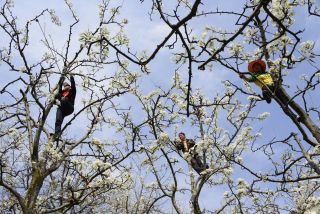Environment
Images Can Lead to Action on Complex Problems
Seeing is believing.
Posted April 17, 2023 Reviewed by Ekua Hagan
Key points
- Conversations are vital to understanding hidden threats, and photos offer a unique entry point.
- Photos that show biodiversity loss can spur an otherwise hard-to-start conversation with kids.
- Instead of avoiding negative emotions, photos of biodiversity loss can be used to fuel inquiry and action.

Today, we’ve asked Lisa Nehring to share her Tip of the Week.
In the front of my classroom, I projected a photo of a group of Chinese farmers in a sunny pear orchard. Surrounded by delicate white flowers, the farmers extend long wands up toward the tree branches.
By looking at this picture, my sixth-grade students came to terms with an astonishing fact: With no bees left, these farmers must pollinate their crops themselves.
Concepts like biodiversity loss are challenging to talk about—especially with children. How do you explain something that’s happening slowly and invisibly? But conversations are vital to understanding hidden threats, and photos offer a unique entry point.
In a recent study conducted on Character Lab Research Network, my colleagues and I found that using photos combined with informational text can lead to a greater sense of appreciation for biodiversity. Participants who saw these photos showing the consequences of biodiversity loss—for example, a koala in the middle of a clearcut forest—acted differently because of it, choosing to donate more money to an environmental organization.
We can’t solve big, scary problems in a day, but photos can spur an otherwise hard-to-start conversation with kids. Begin with the concrete: the what. What do you notice in the photograph? Then move to the why. Why do you think this is happening? You don’t have to know the answers—you can seek them together. Finally, the how. How might things be different? How can you be a part of that shift?
In my classroom, thanks to the curiosity kindled by the photo of the farmers, I pursued additional opportunities for my students to explore the loss of pollinators. We invited a beekeeper to our school, curated a bee section in our class library, and visited pollinator gardens before planting and caring for our own.
Don’t avoid tough discussions about challenging issues.
Do use photos to spark conversations about the environment. Whether you’re concerned about air quality where you live or dying coral reefs around the world, take a closer look at photos and talk about them with the young people in your life. These conversations may be uncomfortable. But instead of avoiding negative emotions, you can use them to fuel inquiry and action.
Lisa Nehring is a former middle school science teacher and a current doctoral student at Johns Hopkins University.


